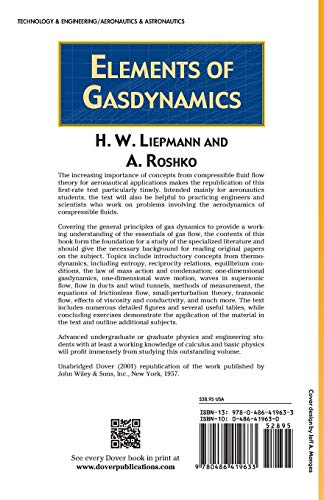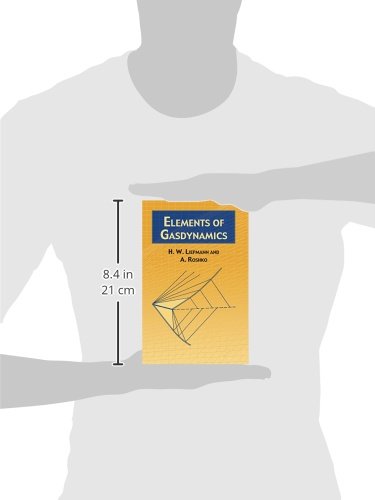



Elements of Gasdynamics
T**X
Great text for compressible flow theory
I used this book to teach myself the basic theory for compressible flow, after focusing on incompressible flow in grad school and having never taken a course on compressible flow. I also got myself a copy of Anderson's Modern Compressible Flow, which I read alongside this text. Since Anderson seems to be one of the more popular texts for the subject, I'll give my thoughts on the two here.I want to say I much preferred this book over Anderson's for two reasons. First, a US edition of Anderson's text costs an order of magnitude more than Liepmann & Roshko (and it certainly isn't an order of magnitude better). Second, L&R is more concise, heavy on derivations, and careful in discussing the physics, while Anderson relies more heavily on example problems. For this reason, I think Anderson is probably more appropriate for an undergrad course, but personally I prefer the former. (If you do want to get Anderson, I recommend the international edition for ~$30).Anderson also emphasizes more "modern" aspects of compressible flow, such as chemical reactions and CFD. But, despite making a big deal about this in the introduction, he relegates a rather small part of the book to these topics. On the other hand, L&R include almost as much information on the chemical reactions found in hypersonic flows. If this is important to you, I still recommend L&R as a primer on compressible flow theory over Anderson, since it will more quickly prepare you to delve into more specialized texts like Zeldovich & Raizer. The same goes for CFD. Although Anderson discusses computational aspects more than L&R, I think you're better off going from L&R to Toro's text if this is something you care about.That said, I would recommend Anderson's text for certain situations. If you are looking for more of the "flavor" of compressible flows, want to be able to solve a few problems and have the basic idea, but aren't so concerned about understanding all the mathematical nuances and don't plan on moving on to more advanced texts on the subject, get Anderson. Liepman & Roshko is an excellent part of a flow library, but Anderson is arguably a better one-stop basic reference.
D**N
This is a classic
We used this in the 1970s for rocket propulsion analysis in the Air Force, in conjunction with another classic - Shapiro's Dynamics of Compressible Fluid Flow.
E**8
Material covered in the Book itself it excellent, but packaging could have be better
The book is an excellent reference, and the text/printing is better than most Dover books. Amazon thought that throwing the book in a flat pack bubble wrap with other heavy objects was a good idea. The book arrived with a corner all messed up. It is like they do not care if an item arrives damaged. In the past Amazon has used these cardboard sort of sleeve things for books that are not perfect, but they are much better than just tossing the book in loose with other items. I need it for a class so i will have to live with it. A couple of days pressed under another few books should make it usable.
S**S
air is a type of gas
This book covers a lot that applies to air flow!
P**G
Good concise reference textbook
My professor recommends this book for its conciseness and depth. Due to the size of the book, it cannot cover all the details, but I think it covers all the theory well. This is the first book I pull to check some equations/theory for compressible flowThe downside is that there are no example problems, this is purely a reference text (not a learning textbook).
A**R
Fantastic overview of gas dynamics
Fantastic overview of gas dynamics. Don't spend the money on a new text book. This one is complete with schlieren photography of experiments. It has been great for teaching and great for a reliable technical reference.
B**I
An absolute classic!!!!
Book as advertised. This was on old text for me back in 1967. Wanted to read it again.Good job. Thanks.
A**E
Five Stars
Its just what I wanted for my academics... It covers almost all the topics from my syllabus.
W**H
Five Stars
Classic book and the foundation for modern CFD.
A**A
Rigore, completezza ma soffre un po' il tempo
Un libro che ha fatto la storia dello studio Gasdinamica: spiega in modo completo gli argomenti di un tipico corso di Gasdinamica (includendo anche argomenti abbastanza specialistici i quali possono essere lasciati da parte per una lettura futura) analizzandone principalmente la fenomenologia fisica nascosta dietro la formulazione matematica; scende in dettagliate spiegazioni in molti degli argomenti trattati, come ad esempio nel capitolo che riguarda le onde d'urto oblique e nel capitolo riguardante gli ugelli. Pur essendo un libro molto utile per gli studenti di Ing. Aerospaziale, ho dato 4 stelle a questo libro poiché è comunque un testo piuttosto datato, certo non obsoleto, ma i capitoli riguardanti la Teoria delle Caratteristiche e gli altri capitoli finali in generale (non proprio di interesse per un corso di Gasdinamica di primo livello) non offrono una trattazione al passo coi tempi (ad esempio nei capitoli sul moto ipersonico che, nel periodo in cui questo libro è stato pubblicato, non era ancora stato studiato in modo approfondito; in conseguenza di ciò la trattazione risulta piuttosto "pesante" da un punto di vista matematico senza che il lettore possa effettuare con agilità un collegamento apprezzabile tra equazioni e realtà fisica). A parte i capitoli finali questo libro è comunque un ottimo acquisto ed è godibilissimo da studiare e da leggere.
R**1
Libro
Libro in buone condizioni. Prezzo conveniente.
A**O
Good Book
Good book on gasdynamics, it is meant especially for aerospace engineers, as the authors suggest.
A**R
Five Stars
All time classic
TrustPilot
3 周前
2 周前